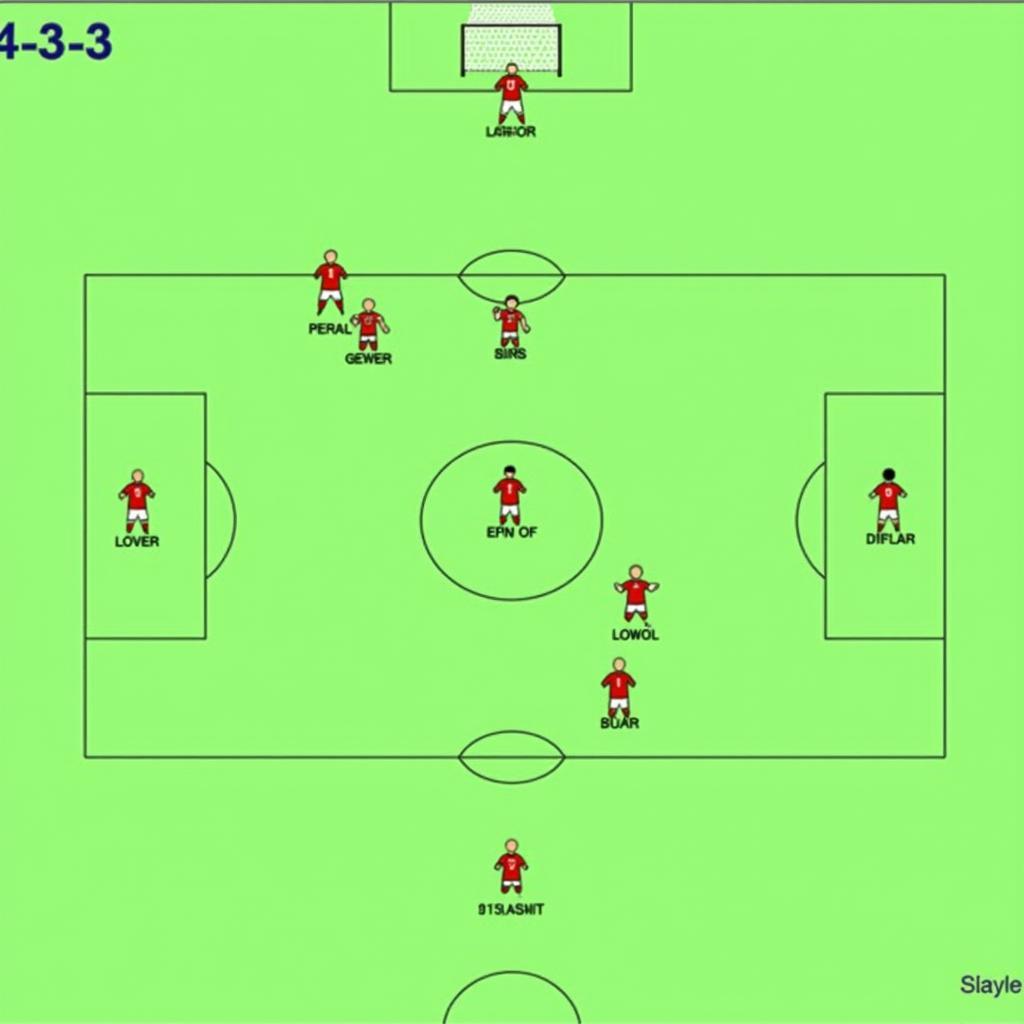Understanding Football Player Diagrams
November 23, 2024Football, a sport of intricate strategies and dynamic movements, relies heavily on player positioning and coordination. Understanding football player diagrams, commonly known as formations, is crucial for both players and fans alike. These diagrams visually represent the strategic layout of a team on the field, offering insights into player roles, team tactics, and potential strengths and weaknesses. Here, we delve into the world of these tactical blueprints.
 Football Player Diagram showing the 4-3-3 Formation
Football Player Diagram showing the 4-3-3 Formation
Decoding the Basics of Football Player Diagrams
Football player diagrams utilize a standardized system to represent player positions. Each player is denoted by a circle, with lines connecting them to indicate their relationships within the team structure. The diagram is typically overlaid on a simplified representation of a football pitch, providing context for player placement in relation to the field dimensions. These diagrams are not static; they evolve throughout a match based on the flow of play and tactical adjustments. You can even find resources like phiếu yêu cầu sang tên hợp đồng điện thủ thiêm near Thu Thiem, showing how detailed planning is essential in various fields.
Common Formations and Their Implications
Various formations exist, each with its own strengths and weaknesses. Some popular formations include 4-4-2, 4-3-3, 3-5-2, and 5-3-2. The numbers correspond to the number of players in each positional group – defenders, midfielders, and forwards (excluding the goalkeeper). For example, a 4-3-3 formation indicates four defenders, three midfielders, and three forwards. Understanding these formations allows you to anticipate how a team might attack or defend. Take, for instance, the 4-3-3, which often signifies a more attacking approach, while a 5-3-2 might suggest a more defensive strategy.
 Tactical Analysis of the 4-4-2 Football Formation
Tactical Analysis of the 4-4-2 Football Formation
How to Read and Interpret Player Diagrams
Reading a player diagram effectively involves more than just recognizing the basic formation. It requires understanding the nuances of player roles within that formation. For instance, a midfielder in a 4-3-3 might play a defensive, central, or attacking role, each with distinct responsibilities. Furthermore, the spacing between players on the diagram can indicate the team’s intended playing style. A compact formation might suggest a focus on short passing and possession, while a more spread-out formation might indicate a reliance on long balls and counter-attacks. Just like searching for nhà trọ gần cầu thủ thiêm, understanding these diagrams requires careful observation and analysis.
The Role of Player Diagrams in Tactical Analysis
Player diagrams are invaluable tools for tactical analysis. They provide a visual framework for understanding a team’s strategic approach, allowing analysts and coaches to identify potential weaknesses and exploit them. These diagrams can also be used to analyze past matches, identifying patterns in player movement and tactical adjustments. This kind of analysis can be crucial for improving team performance and preparing for future opponents.
 Football Player Diagram: Strategic Positioning in Attacking Scenarios
Football Player Diagram: Strategic Positioning in Attacking Scenarios
Conclusion
Football player diagrams provide a window into the tactical intricacies of the beautiful game. By understanding these diagrams, you gain a deeper appreciation for the strategic thinking that goes into every match. Whether you are a seasoned analyst or a casual fan, knowing how to read and interpret player diagrams enriches your understanding of football and allows you to appreciate the game on a whole new level. Check out the tiến độ cầu thủ thiểm 2 for another example of detailed planning and execution.
FAQ:
- What is the most common football formation?
- What do the numbers in a formation represent?
- How can player diagrams help in tactical analysis?
- What are some key things to look for when interpreting a player diagram?
- How do player diagrams help predict team strategy?
- What are some online resources for learning more about football formations?
- Where can I find up-to-date player diagrams for specific teams?
Situations where these questions might be asked:
- During a football match discussion with friends
- While analyzing a game with a coach or teammate
- When researching football tactics online
- While preparing for a fantasy football draft
Other Related Articles:
Need help? Contact us 24/7 at Phone Number: 0396443476, Email: [email protected] or visit our office at 23 Tháng 3, Đắk Nia, Gia Nghĩa, Đắk Nông, Việt Nam.